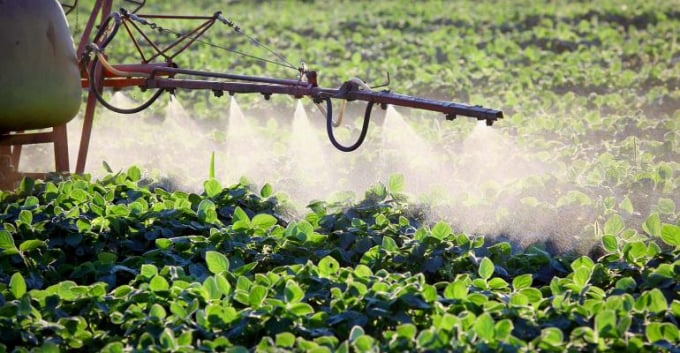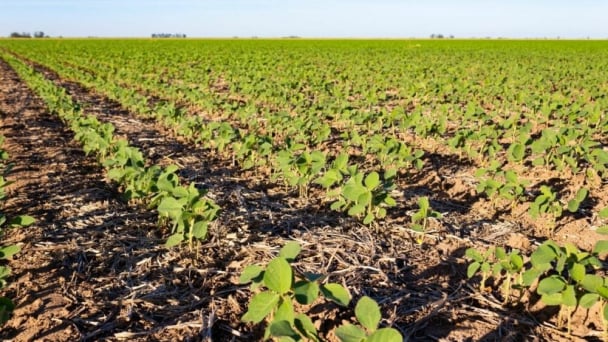May 16, 2025 | 10:44 GMT +7
May 16, 2025 | 10:44 GMT +7
Hotline: 0913.378.918
May 16, 2025 | 10:44 GMT +7
Hotline: 0913.378.918

New research shows preventative foliar fertilizer applications decrease profitability. Photo: FP
Emma Matcham, a researcher at University of Wisconsin-Madison, studies soybeans and their response to foliar fertilizer applications. The team’s research was recently published in Agronomy Journal.
Farmers have shown interest in using foliar-applied nutrients to increase soybean yields since the 1970s. Foliar fertilizer products for soybeans have spiked recently, likely due to elevated soybean prices.
Matcham’s research specifically investigates the effectiveness of preventative applications. This means foliar fertilizer is applied when soybeans show no visible nutrient deficiency. “This differs from ‘rescue’ foliar fertilizer applications made in response to low tissue nutrient concentration tests or visible symptoms of nutrient deficiency,” she explains.
When it comes to the benefits of using foliar fertilizer, research shows conflicting results. There is limited evidence suggesting foliar-applied products offer consistent yield gains.
Previous studies have mainly been isolated in the upper Midwest. Matcham’s research team expanded their study across 16 different states to assess the effects of macro- and micro-nutrient foliar fertilizer across the primary soybean producing region of the U.S.
The study took place during 2019 and 2020 using foliar products commonly marketed to soybean producers. The team set out to:
Identify soybean yield response to foliar fertilizer across a range of environments
Determine if foliar fertilizer application changes soybean grain composition
Conduct economic analysis of the value of foliar products
Does preventative foliar fertilizer work?
With 46 sites in 16 different states, the study included a wide range of soil and environmental conditions. When it comes to yield, there is no evidence that preventative foliar fertilizer applications increase soybeans yield.
Similarly, foliar fertilizer treatments did not lead to a difference in grain protein or oil content. “At nutrient application rates currently recommended by foliar fertilizer manufacturers, there is no evidence that fields that receive foliar fertilizer should be expected to have different grain protein or oil content,” the study states.
Even when the preventative foliar applications do improve yield, the relatively small yield increase does not pay for the cost. For this research, application costs were not factored in since foliar fertilizer products are frequently applied in a tank-mix with fungicide or insecticide.
The study concludes that foliar fertilizer applications in the absence of visual deficiency symptoms are likely to decrease the profitability of soybean production.
Advice for farmers
“Given the low impact foliar fertilizers had on yield in this study and other trials involving similar products, I would advise farmers to focus on other aspects of their crop production and fertility regime,” Matcham says. “Foliar fertilizers are unlikely to aid in farm profitability this year, especially as input costs rise.”
Matcham suggests scouting soybean fields regularly to watch for nutrient deficiency. If the crop shows visible signs of a deficiency, address it with a rescue application of foliar fertilizer that contains the nutrients limiting crop growth.
According to the study, foliar fertilizer products tested in this research and similar products should not be recommended to soybean farmers in the absence of visual symptoms of nutrient deficiency.
Learn more about this work here. This research was supported by Soybean Checkoff funds through the Qualified State Soybean Board in each state. Additional support was provided by the United Soybean Board.

Planting wheat in a research trial last fall. Photo: FP
With input costs biting away at margins, is it time to put some of your acreage to work making money with two crops in 2022. The profit potential is compelling:
75 bu. per acre wheat yields X $7 (Jul22 forward contract is $7.42) = $525/acre revenue
43 bu. per acre soybean yields X $12 (Nov22 forward contract is $12.46) = $516/acre revenue
Of course this equation assumes a lot of good things will happen, mainly, that weather or other issues don’t ding yields. But these yield estimates are fairly conservative, even for double crop soybeans.
And prices? Well, you could risk it and hope these prices will still be there next July and fall. Or you can use a simple risk management tool to lock in profit now.
Acreage battle
Let’s start with the need to protect those high prices for next year’s harvests of wheat and soybeans. Recent spikes in fertilizer prices added another $10 per acre in corn costs, bringing total price increases to 45% since spring, according to our recent analysis. That’s enough to knock 35 cents per bu. off operating margins for 2022 corn – resulting in more soybeans going in the ground next spring. That higher soy acreage, combined with Brazil adding 2 million more soy acres, could overwhelm the market by next fall.
“Anhydrous is a big issue, maybe as much next fall as this next spring,” says Matt Bennett, a central Illinois grain farmer and market analyst with AgMarket.Net. “That’s driven by a fear in the industry that there is going to be fertilizer shortages. Several countries are talking about energy shortages, and you don’t just pull anhydrous out of the ground; you have to use some energy to make it.
“So, if you’re looking at double the cost of nitrogen, it’s pretty tempting to plant more beans,” says Bennett. “Then you look at what wheat prices are doing now. Wheat followed by beans is quite the performer.”
To be sure, there are still costs associated with planting two crops for 2022 harvest. University of Illinois 2022 crop budgets for Southern Illinois pencil in $137 per acre fertilizer costs for wheat, and $29 per acre for soybean fertilizer. Seed costs will run nearly $50 per acre for each crop.
Still, current futures prices should cause more drills to come out of the machine shed this fall.
“It’s crazy what some people can make, planting wheat followed by beans,” says Bennett. “You can lock in an incredible income.”
Lock in prices
One of the simplest things you can do now is write an HTA (hedge-to-arrive) contract for wheat for next July, and also for soybeans for next fall. You hedge that crop without any margin call.
“For a producer who doesn’t want a hedge account, you’ll probably pay 8 to 10 cents a bu. to the elevator to write an HTA on $7.45 wheat,” explains Bennett. “So what? How many times have you been able to lock in $7.35 per bu. wheat when you’re planting? It’s not that often.”
You can also consider an options strategy, says Bennett. “For soybeans you can buy a Nov22 $12 put, sell a $10 put and sell a $14 call, to help finance the purchase of the $12 put,” he says. “Essentially, we’re locking in $12 beans for around 10 cents per bu. cost. That gives some assurance that hey, if the market gets hot and runs up to $14 per bu., I’m still participating in that rally. Yet, you still have a strong floor underneath you.”
AgMarket.net has been recommending clients forward contract 50% of next year’s soybean production – an aggressive stance, to be sure. But to Bennett it’s a no-brainer.
“It is, after all, a futures market, and we have no idea what will happen in South America, but they’re adding 2 million acres of soybeans this year,” he says. “And with fertilizer prices the way they are it looks like there will be a lot of incentives to plant beans next year.
“In the end, $12.60 beans are pretty hard to pass up,” he says. “As a producer how can you go wrong? You have to work pretty hard not to make money at those prices.”
(Farm Progress)

(VAN) Fourth most important food crop in peril as Latin America and Caribbean suffer from slow-onset climate disaster.

(VAN) Shifting market dynamics and the noise around new legislation has propelled Trouw Nutrition’s research around early life nutrition in poultry. Today, it continues to be a key area of research.

(VAN) India is concerned about its food security and the livelihoods of its farmers if more US food imports are allowed.

(VAN) FAO's Director-General emphasises the need to work together to transform agrifood systems.

(VAN) Europe is facing its worst outbreak of foot-and-mouth since the start of the century.

(VAN) The central authorities, in early April, released a 10-year plan for rural vitalization.

(VAN) Viterra marked a significant milestone in its carbon measurement program in Argentina, called Ígaris, reaching 1 million soybean hectares measured.